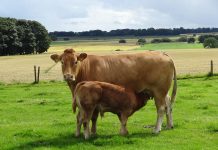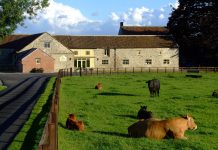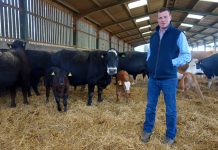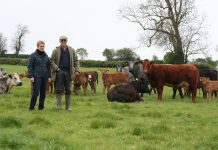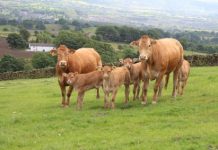An emphasis on growth rates and good grades is the key to success for the Dandie Family, who farm at Learielaw, Broxburn, near Edinburgh; and they find Limousin-cross calves fit the bill for their butcher customers.
They finish 350 to 400 home-bred and bought-in cattle every year and consistency of the finished product is critical as the main customers are two local butchers who take around 300 head per year.
Learielaw is farmed by the partnership of Walter Dandie & Sons, which was established in 1945, and now consists of Walter, his brother Robert and his cousin David. Walter’s wife Margaret is responsible for the book work and his two sons, David and William also work on the farm.
The family bought Learielaw, which runs along both sides of the picturesque Union Canal, about 40 years ago and since then they have taken on land around the area on a contract farming basis. They now farm around 2000 acres, 1700 of which is arable and sown in winter and spring barley, winter wheat and oilseed rape. The remainder is a mixture of permanent and temporary grass, with about 90 acres cut for silage.
Walter is responsible for the finishing cattle enterprise which consisted mostly of bought-in suckled calves, however William was keen to expand the breeding enterprise and in 2008, when they made the decision to give up growing potatoes, they started to expand the suckler herd.
They now have 100 Limousin-cross suckler cows and plan to increase to around 120, so they have enough heifer replacements for their own use and hopefully some surplus to sell with calves at foot. They also started up a small pedigree herd of their own under the Learielaw prefix, and now have three cows.
The cows all calve in a strict ten-week period starting in the first week of February. This year a camera was set up in the shed and William said they had the best calving ever while taking some of the pressure off the family. Brother David also helps at this time of year. William explained, “We have to keep the calving period tight so we are free to get on with the spring arable work; we are fairly ruthless about culling anything that does not hold to the bull.”
Good Limousin cull cow prices
He added that the sting was taken out of culling by the good prices received for quality Limousin-cross cows. Scaling around 700 to 800kg, they come to between £1100 and £1400, which goes a long way to finding a replacement.
Four bulls are used on the herd, three Limousins and a British Blue so that when the cows get up to three-quarter or seven-eighths Limousin, they regain some hybrid vigour by crossing back with the Blue.
At Carlisle in 2010 the Dandies spent the most they had ever spent on a bull when they paid 12,000gns for Marlepark Director. They were delighted with his calves but he sadly broke his back last year, so they have kept a son of his out of one of their pure-bred cows and are hoping that Learielaw Hector leaves the same stamp on his calves. William said, “When we were drawing calves, we could easily tell which were by Director because of the top on them.”
Bulls are selected for growth rates and shape, and, while they believe figures play a part in fine-tuning their selection, both Walter and William like to see the bulls in the flesh first.
Last Autumn, Emslies Hendreron caught their eye at Stirling, but they had to go to 15,000gns to secure him. They did not want to make the same mistake as they did with Director, so they immediately took semen off him and they are now looking forward to his first calves being born in February. The third bull is Fodderletter Gatuso bought at Carlisle in 2012 for 10,000gns.
Heifers are synchronised and AI’d, this year to the Emslies bull, so they calve early to give them the best chance to hold early to the bull the next time round and this has worked well for the Dandies.
Cows and calves come in at the end of October, when they are also weaned and the cows are fed a diet of straw and minerals until calving. The calves are creep fed on a Galloway MacLeod blend from August before coming in and going on to a Total Mixed Ration (TMR) consisting of silage, home-grown barley and wheat dark grains.
The forward calves are kept inside and finished at 16 to 17 months, while some of the smaller ones and the heifer calves have a second summer at grass before being finished the following winter. Walter said, “We do not finish anything off grass because it is important to get a consistent finish on them when we are supplying a batch every week to the same customers.”
The family have been supplying Fell and Sharp, Butchers, at Whitburn since 1968 and this company plus Thomas Johnston, Butchers, at Airdrie take 300 cattle between them each year from Learielaw. Christmas is an especially busy time with Johnstons taking 30 to 40 head per week on the run up to the holidays.
Each week a batch is killed at Shotts Abattoir where they consistently grade U3 and U4, although the butchers prefer them to be 3 and not too fat. They kill out at between 65 and 70% giving deadweights of between 400 and 450kg.
Limousin kills out well with very little waste
Walter said, “One of the big advantages of the Limousin breed is that it kills out so well and the butchers like it because there is so little waste.”
Surplus cattle are sold through the ring at Caledonian Marts, Stirling. Walter pointed out that, in order to keep the butchers supplied with a consistent product, they always have some left over which have no problem finding homes, sometimes even with the same butchers, who end up buying them through the ring.
Walter is also in charge of buying suckled calves to supplement the home-bred stock and he makes sure he always buys at the prime spring and autumn sales at Stirling, Lanark, Carlisle and Hexham, often from the same well-known producers such as John Robertson of Logierait and Wilson Peters of Monzie.
Hi-spec Limousin calves
He said, “Nearly all the calves are Limousin-cross and I may have to pay a bit more for them but they match the specification of our own calves.” William added, “Having a mixture of home-bred and bought-in spreads the risk – sometimes we make more from our own cattle and sometimes from purchased.”
Walter pointed out that the price is back a bit just now but the finished cattle are still coming to £1500 to £1650 per head. It helps that he agrees a price with the butchers beforehand which takes some of the weekly market fluctuations out of the equation. However Walter said, “I think cattle at £4.20 or £4.30 per kilo were too expensive for the housewife, but at less than £4 there is not enough margin for the finishers. It is a hard balancing act.”
With a large arable enterprise as well as the cattle business, the old adage of “Down corn, up horn” works both ways for them. William said, “The two enterprises dove-tail nicely together, as we can add value to grain by feeding cattle, we bed all our cattle on wheat straw and sell quite a bit of surplus barley straw and of course we get the dung back to help the crops.”
His aim going forward is to increase the sucklers and have a surplus of heifers which he plans to bull and sell with calves at foot. He would also dearly love to breed a bull good enough to sell at either Stirling or Carlisle but admits he is quite ruthless when it come to cutting his bull calves and does not keep anything that he would not consider using himself. Hector was destined for Stirling before he stepped in to replace Director, but there is a youngster showing a bit of promise now, so he may make his debut in the sale ring in the not too distant future.
In the meantime William enjoys showing the occasional prime calf. He is on the committee of the Scottish National Fat Stock Club and has shown with some success at the Winter Fair in recent years.










